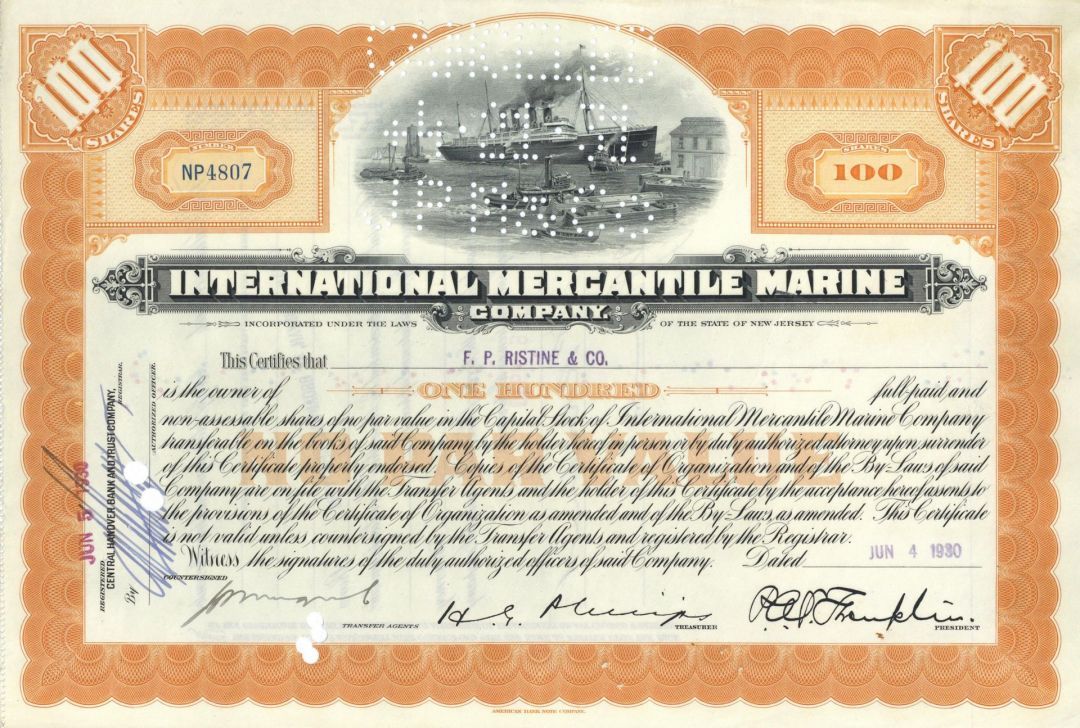International Mercantile Marine - Company that Made the Titanic - Stock Certificate
Inv# SS1006 StockShipping Stock. Famous 'Titanic' stock. This co. owned White Star Lines & the Titanic. Vignette of ship similar to Titanic with tugboats. A Classic!!! Please specify color.
The International Mercantile Marine Company, originally the International Navigation Company, was a trust formed in the early twentieth century as an attempt by J.P. Morgan to monopolize the shipping trade.
IMM was founded by shipping magnates Clement Griscom of the American Line and Red Star Line, Bernard N. Baker of the Atlantic Transport Line, J. Bruce Ismay of the White Star Line, and John Ellerman of the Leyland Line. The Dominion Line was also amalgamated. The project was bankrolled by J.P. Morgan & Co., led by financier J. P. Morgan. The company also had working profit-sharing relationships with the German Hamburg-Amerika and the North German Lloyd lines. The trust caused great concern in the British shipping industry and led directly to the British government's subsidy of the Cunard Line's new ships RMS Lusitania and RMS Mauretania in an effort to compete.
Since 1902, IMM had an agreement with James Pirrie, chairman of Harland & Wolff and member of the management of the White Star Line, stating that the vessels of the company will be built by Harland & Wolff for all the time. Ships of the company were also shifting from one company to another, like the Belgic, built for the White Star Line, which was transferred to the service of the Red Star Line under the name SS Belgenland (1914), or the Regina became the Westernland. This allowed the IMM to schedule a ship each day from the United Kingdom, and passengers to change their tickets to a position equivalent to another vessel of the company. Baker retired from the direction of the Atlantic Transport Line shortly after its integration with the IMM, and was replaced by Philip Franklin. He later became vice president of IMM, while Griscom was replaced as president by Joseph Bruce Ismay in 1904 (who was also president of the White Star Line).
The early 1910s marked a turning point for the IMM. Indeed, on 15 April 1912, the Titanic, flagship of its fleet, sank during her maiden voyage. Besides the financial and human losses, the sinking had repercussions on the organization of the trust. Through the American commission of inquiry devoted to the sinking, Senator William Alden Smith openly attacked the very principle of the company and Morgan. As had been arranged before Titanic sank, J. Bruce Ismay retired as president of IMM in 1913 and was succeeded by Harold Sanderson and Morgan died on 31 March 1913. After the 1915-16 receivership, Sanderson was succeeded as president by Franklin, who had been the receiver.
However, the sinking of the Titanic did not bring about the end of the IMM. Although theoretically powerful due to its continued influence with some of the top American, British, and German shipping companies, the overseeing company never managed to overcome its own financial problems, nor dominate the bulk of the North Atlantic shipping trade, and was therefore not as successful as expected. The company went into receivership in 1915 and was placed in the hands of Franklin, who managed to save it. In the late 1920s, he received grants from the government to American ships (built in the United States or flying the flag) and in 1926 it sold the White Star Line to the Royal Mail Steam Packet Company for £7 million, of which £2.35 million was still unpaid when the Royal Mail Group, which was overleveraged and undercapitalized, collapsed in the early 1930s. In 1930, IMM possessed 30 vessels. There were 19 in 1933 and only 11 by 1935. Read more at https://en.wikipedia.org/wiki/International_Mercantile_Marine_Company
A stock certificate is issued by businesses, usually companies. A stock is part of the permanent finance of a business. Normally, they are never repaid, and the investor can recover his/her money only by selling to another investor. Most stocks, or also called shares, earn dividends, at the business's discretion, depending on how well it has traded. A stockholder or shareholder is a part-owner of the business that issued the stock certificates.










Ebay ID: labarre_galleries